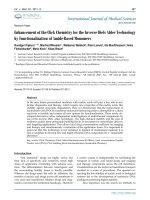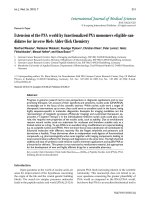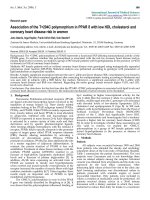Báo cáo y học: " Efficacy of the Valsalva Maneuver on Needle Projection Pain and Hemodynamic Responses During Spinal Puncture"
Bạn đang xem bản rút gọn của tài liệu. Xem và tải ngay bản đầy đủ của tài liệu tại đây (384.43 KB, 5 trang )
Int. J. Med. Sci. 2011, 8
156
I
I
n
n
t
t
e
e
r
r
n
n
a
a
t
t
i
i
o
o
n
n
a
a
l
l
J
J
o
o
u
u
r
r
n
n
a
a
l
l
o
o
f
f
M
M
e
e
d
d
i
i
c
c
a
a
l
l
S
S
c
c
i
i
e
e
n
n
c
c
e
e
s
s
2011; 8(2):156-160
© Ivyspring International Publisher. All rights reserved.
Research Paper
Efficacy of the Valsalva Maneuver on Needle Projection Pain and Hemo-
dynamic Responses During Spinal Puncture
Sussan Soltani Mohammadi, Amin Ghasemi Pajand, Gita Shoeibi
Department of Anesthesiology, Tehran University of Medical Sciences, Dr Shariati Hospital, TEHRAN, IRAN
Corresponding author: Gita Shoeibi, M.D. Department of Anesthesiology, Dr Shariati Hospital, North Kargar Street,
Ale-Ahmad Highway, Tehran 1411713135, IRAN. Tel: +98-912-1226683 (Cell); Fax: +98-21-88633039 (Hospital); E-mail:
Received: 2010.10.24; Accepted: 2011.02.08; Published: 2011.02.16
Abstract
This study evaluated the efficacy of the valsalva maneuver that can induce baroreceptor ac-
tivation and nociception, on needle projection pain and hemodynamic responses associated
with spinal puncture. Ninety adults, ASA physical status I and II undergoing elective surgeries
were included. Patients were randomized into three equal groups. Group I (C): control;
Group II (B): ball; pressed a rubber ball (attention-diverting method); Group III (V): valsalva;
blew into sphygmomanometer tubing and hold the mercury column up to 30 mm Hg for a
period of at least 20s. Spinal needle projection pain was graded using numeric rating scale
(NRS): 1–10, where scales of 1–3 were rated as mild, 4–6 as moderate, and > 6 as severe.
Blood pressure and heart rate, five minutes before the procedure, during the spinal puncture
and first and third minutes after that, were also recorded. Significant reduction in NRS was
observed in the valsalva group compared with the control and the ball groups (p=0.001).
There were statistical but no significant clinical differences in mean arterial blood pressure and
heart rates between the study groups (P=0.008 and P=0.016 respectively). In conclusion
valsalva maneuver can decrease the skin puncture pain associated with spinal needle projec-
tion while observing hemodynamic changes.
Key words: Hemodynamic response; Lumbar puncture; Pain; Spinal anesthesia; Valsalva maneu-
ver.
Introduction
Spinal anesthesia is a simple and reliable method
of anesthetizing lower part of body. However many
people refuse it because of fear of needle and back
pain.
1
Many techniques have been used to obtund pain
of needle insertion including infiltration analgesia and
EMLA patch. Local anesthetics themselves may pro-
duce pain on injection and many anesthetists are un-
sure that infiltration analgesia at the site of spinal
puncture has any advantage over a straightforward
puncture without analgesia.
2, 3, 4
The pain experienced during spinal puncture has
both somatic and psychological components. Phar-
macological measures, such as the application of local
anesthetics, treat only the somatic component of pain,
whereas attention-diverting measures (pressing ball)
address only the psychological component of pain.
4,5,6
A literature search revealed laboratory studies
showing that baroreceptor activation induces noci-
ception but there were few clinical studies exploring
the effect of the Valsalva maneuver on pain.
6-10
In a study by Agrawal et al, Valsalva maneuver
performed before venous canulation could decrease
the incidence and severity of pain associated with
venipuncture in adult patients.
7
In another study by Gupta et al the efficacy of
Int. J. Med. Sci. 2011, 8
157
balloon inflation were evaluated on venipuncture
pain in children aged 6-12 year and there was a sig-
nificant reduction of pain in balloon group compared
with distraction and control groups.
8
This study evaluated the efficacy of Valsalva
maneuver on needle projection pain and hemody-
namic responses during spinal puncture.
Methods and Materials
This randomized clinical trial was performed in
Dr.Shariati Hospital of Tehran University of Medical
Sciences from January to March 2010. The study pro-
tocol conformed to the ethical guidelines of the 1989
Declaration of Helsinki.
Ethics Statement
To evaluate the effect of valsalva maneuver on
pain, first, we searched Medline, ISI, and other data-
bases. This intervention was noninvasive and previ-
ous studies reported that baroreceptor activation in-
duces nociception. This trial was then registered with
and approved by the Research Ethics Committee of
Tehran University of Medical Sciences and Iranian
Registry of Clinical Trials. Patients were instructed
about the procedure and informed consent was ob-
tained separately before surgery.
Participants and measurements
Ninety consecutive adults’ patients, either sex
with ASA physical status I and II, scheduled for elec-
tive surgeries under spinal anesthesia, were included.
Patients having problems in communication, any
contraindications to spinal anesthesia and Patients
who could not hold the mercury column up to 30 mm
Hg for a period of at least 20s and whose spinal
puncture could not be performed in the first attempt
were excluded.
Using a computer-generated randomization list,
Patients were allocated into three equal groups.
Group I (C): control; Group II (B): ball; pressed a
rubber ball (attention-diverting method); Group III
(V): valsalva; blew into sphygmomanometer tubing
and hold the mercury column up to 30 mm Hg for a
period of at least 20s.
Spinal needle projection pain was graded using
numeric rating scale (NRS): 1–10, where scales of 1 –3
were rated as mild, 4–6 as moderate, and > 6 as severe
pain.
In a pilot study of 20 patients having spinal an-
esthesia by 25-guage Quincke needle without intro-
ducer and any local infiltration, 90% of them had
moderate to severe pain using NRS and nobody had
NRS=0 (unpublished observation). According to this
pilot study the NRS was graded from 1 to 10.
Before the surgery, patients were instructed
about the Numeric Rating Scale (NRS) and how to
blow into sphygmomanometer tubing.
All patients were premedicated with 10 mg di-
azepam given orally on the morning of surgery. On
arrival in the operating room, ECG electrodes and
non-invasive blood pressure (NIBP) monitor were
applied and oxygen saturation was monitored by
pulse oxymeter.
Patients were hydrated with 5ml.kg
-1
ringer lac-
tate solution. Spinal anesthesia was performed in lat-
eral position by 25-guage Quincke needle without
introducer.
The puncture pain was assessed by the patients,
immediately after being placed supine for surgery
using numeric rating scale (NRS).
Blood pressure and heart rate five minutes be-
fore the procedure, during spinal puncture and first
and third minutes after that were also recorded.
Statistical analysis
In a pilot study of 20 patients having spinal an-
esthesia by 25-guage Quincke needle, 90% of them
had moderate to severe pain using NRS (unpublished
observation). Presuming that valsalva maneuver
during spinal needle projection would reduce pain to
50%; one would need to enroll 30 patients in each
group for the results to be statistically significant at a
power of 95% with a level of confidence of 5%. Data
were analyzed by SPSS version 11.5(SPSS Inc., Chi-
cago, IL). Normality of distribution was tested by
Kolmogorov Smirnov test. One-way ANOVA, Krus-
kal Wallis, Chi-square and Fishers exact tests were
used when appropriate. Repeated measures ANOVA
and post Hoc Tukey tests were used for comparing
hemodynamic responses between the study groups.
P<0.05 was considered statistically significant.
Results
There were no statistical differences in the de-
mographic data between the study groups (P>0.05)
(Table 1).
A significant reduction in NRS was observed in
the valsalva group compared with the control and the
ball groups (p=0.001) (Table 2).
The mean arterial pressure (MAP) throughout
the time intervals of prespinal procedure to the third
minutes after that were statistically different between
the study groups (P= 0.008).
Post Hoc Tukey test showed there was statistical
difference in MAP between the ball and the control
groups at third minutes after spinal anesthesia
(p=0.007) (Fig 1).
The mean heart rate (HR) throughout the time
Int. J. Med. Sci. 2011, 8
158
intervals of prespinal to the third minutes after that
were statistically different between the study groups
(P= 0.016).
Post Hoc Tukey test showed there was statistical
difference in HR between the ball and the control
groups at third minutes after spinal anesthesia
(p=0.003) (Fig 2).
Table 1. Comparing demographic data between the study groups.
Variable Group I(Control)
N=30
Group II(Ball)
N=30
Group III(Valsalva)
N=30
Age (year)
a
31.9±8.4 38.5±19.4 39.2±12.5
Sex (M/F) 15/15 19/11 20/10
ASA Class (I/II) 26/4 22/8 22/8
Weight (Kg)
a
75.0±12.6 70.2±5.9 68.8±11.2
a: Data are presented as mean ± SD
There were no significant statistical differences between the study groups, P>0.05
Table 2. Severity of spinal needle projection pain in the study groups
Severity of pain
(NRS)
a
Group I(control)
(N=30)
Group II(ball)
(N=30)
Group III(valsalva)
(N=30)
Mild (1-3) 9(30%) 6(20%) 21(70%)
Moderate (4-6) 19(63.3%) 24(80%) 9(30%)
Sever (7-10) 2(6.7%) 0(0%) 0(0%)
Data are presented as number (percent) of patients
Fisher exact test, P<0.001 between study groups
a: NRS= numeric rating scale
Figure 1: Comparing mean arterial blood pressure between the study groups five minute before spinal anesthesia (SA),
during the procedure and first and third minutes after that, P = 0.008 between the study groups.
Int. J. Med. Sci. 2011, 8
159
Figure 2: Comparing heart rate (HR) between the study groups five minute before spinal anesthesia (SA), during the
procedure and first and third minutes after that( P=0.016 between the study groups).
Discussion
This study suggests that performing Valsalva
maneuver during spinal needle projection reduces the
severity of spinal needle puncture pain.
During valsalva maneuver intrathoracic pres-
sure increases. This increase results in compression of
the vessels within the chest and in turn results in
baroreceptor activation. Activation of either the car-
diopulmonary baroreceptor reflex arc or the sinoaor-
tic baroreceptor reflex arc induces antinociception.
9,10
There were few studies for evaluating the effi-
cacy of balloon inflation on venipuncture pain in pe-
diatric and adult patients.
In a study by Gupta et al on seventy-five pediat-
ric patients aged 6–12 yr, the efficacy of balloon infla-
tion for attenuating venipuncture pain was evaluated.
Pain was self-reported by a pain face scale with a
10-cm visual analog scale (VAS) placed at its back,
where 0=“no pain” and 10 = “worst imaginable pain”.
VAS scores of 1- 3 were rated as mild, 4–6 as moder-
ate, and 6 as severe.
Median (interquartile range) VAS score in the
balloon group was 1 (3), which was reduced as com-
pared with 2 (2) and 4 (2) observed in the distraction
and control groups respectively (p= 0.000). Significant
reduction in the incidence and severity of venipunc-
ture pain was also observed in the balloon group
compared with the other 2 groups (p<0.05).These
findings were correlated with our study.
In another study by Agrawal et al, the efficacy of
the Valsalva maneuver on pain associated with ve-
nous canulation were evaluated on Seventy-five
adults patients undergoing elective surgeries. They
were randomized into three groups of 25 each. Group
I (C): control; Group II (V): blew into sphygmoma-
nometer tubing and raised the mercury column up to
30mmHgfor 20 s; Group III (B): pressed a rubber ball.
Twenty seconds later, peripheral venous canulation
was performed. Venous canulation pain was graded
using a 4-point scale: 0–3, where 0= no pain, 1= mild
pain, 2= moderate pain and 3= severe pain, and visual
analog scale of 0–10, where 0=no pain and 10= worst
imaginable pain.
Agrawal et al used both, 4-point scale and VAS,
in which the first scaling was used during the canula-
tion and VAS was used after the canulation. They
found a significant reduction in the incidence of pain
in the Valsalva group: 18 of 25 (72%) patients, whereas
25 of 25 (100%) experienced pain in the other two
groups (p<0.001). These findings were also correlated
with our study.
In our study, only 9(30%) of patients had mod-
erate and severe pain in valsalva group, where 24
(80%) in ball group and 21 (70%) in control group had
moderate and sever pain.
Since Valsalva maneuver may induce Bradycar-
dia and hypotension that are important during spinal
needle projection, we also recorded hemodynamic
responses that were not studied in previously men-
Int. J. Med. Sci. 2011, 8
160
tioned studies.
There were statistical differences in MAP and
HR at third minutes after the spinal puncture between
the ball and the control groups, these differences were
not related to valsalva maneuver.
In conclusion we suggest that Valsalva maneu-
ver can decreases the skin puncture pain associated
with spinal needle projection while observing hemo-
dynamic changes.
Acknowledgement
This study was supported by a grant from Teh-
ran University of medical Sciences.
Implications Statement: Valsalva maneuver can
decrease the severity of spinal needle projection pain
with no significant clinical hemodynamic changes.
Conflict of Interest
The authors have declared that no conflict of in-
terest exists.
References
1. Gajraj NM, Sharma S, Souter AJ, Pole Y, Sidawi E. A survey of
patients who refuse regional anesthesia. Anesth Analg 1994;
78:s126.
2. Morris RW, Whish DKM. A controlled trial of pain on skin
infiltration with local anesthetics. Anesth and inten care 1984;
12:113-4.
3. Morris R, McKay W, Mushlin P. Comparison of pain associated
with intradermal and subcutaneous infiltration with various
local anesthetic solutions. Anesth Analg 1987; :1180-2.
4. Kocielniak-Nielsen Z, Hesselbjerg L., Brushoj J, et al. EMLA
patch for spinal anesthesia, a comparison of EMLA patch with
lidocaine infiltration and placebo patch. Anesthesia 1998;
53:1209-1227.
5. Patterson P, Hussa AA, Fedele KA et al. Comparison of 4 an-
algesic agents for venipuncture. AANA J 2000; 68: 43–51.
6. Usichenko TI, Pavlovic D, Foellner S, Wendt M. Reducing
venipuncture pain by a cough trick: a randomized crossover
volunteer study. Anesth Analg 2004; 98: 343–5.
7. Agarwal A, Sinha P.K, Tandon M, Dhiraaj S, Singh U. Evaluat-
ing the Efficacy of the Valsalva Maneuver on Venous Cannula-
tion Pain: A Prospective, Randomized Study. Anesth Analg
2005; 101:1230–2.
8. Gupta D, Agrawal A, Dhiraaj S, et al. An evaluation of balloon
inflation on venous canulation pain in children: a prospective,
randomized, controlled study. Anesth Analg 2006;102:1372-5.
9. Randich A, Maixner W. Interaction between cardiovascular and
pain regulatory systems. Neurosci Biobehav Rev 1984;8:343–67.
10. Ghione S. Hypertension – associated hypalgesia. Evidence in
experimental animal and humans, pathophysiological mecha-
nisms, and potential clinical consequences. Hypertension
1996;28:494–504.









